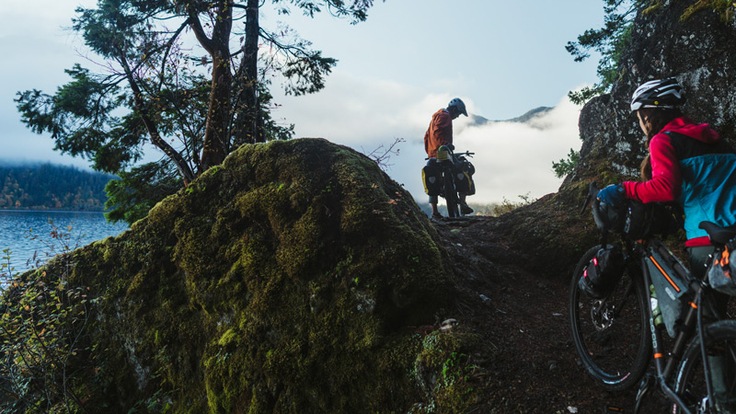Part backpacking and part bike-touring, bikepacking is a fun choice for cycling buddies, couples and families who ride together. It lets you cover more miles than hiking, plus you can access dirt roads and trails that are inaccessible to other vehicles. Rides range from local overnighters all the way up to epic cross-country trail rides.
If you're interested in getting started bikepacking, read on to learn about:
- What bike to ride: You need one capable of handling the terrain you choose
- How to pack your gear: Options include daypacks, panniers, frame bags and more
- What gear to bring: You'll need basic bike items, plus backpacking gear
- Trip-planning tips: Learn where you can bikepack
- Riding tips: Carrying all that gear can take some getting used to
- Bikepacking resources: There are a number of great online resources for even more information
Bikepacking Bikes
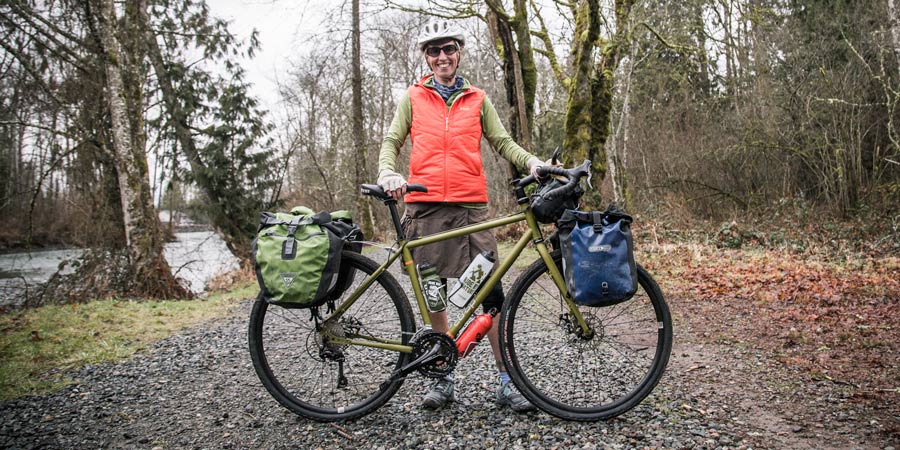
Many bikepacking destinations are reached via forest-service roads or singletrack trails, so a mountain bike makes an ideal choice. But virtually any bike that can mount racks and/or storage bags can be used. New handlebar grips or bar ends can be added to increase comfort for long days.
Avid bikepacking enthusiasts may tailor their bike for riding style or terrain, but most upgrades aim to minimize maintenance or maximize comfort.
The ideal for many: a rigid (no suspension or a suspension fork with lockout) 29er or 27.5 mountain bike with mechanical disc brakes and a multi-position handlebar. Internal gear hubs are popular, too, as they minimize maintenance (downside: They are harder to deal with when repairing a flat). While nice, such a setup is not required to have fun.
Learn more in our article, How to Choose a Bike for Bikepacking.
Gear Carrying Options for Bikepacking
Bikepackers carry the same gear as backpackers plus spare bike tools and tubes. Fortunately, you have more places to carry it on a bike.
Unlike backpacking, you don't want to carry a lot of weight on your back. Instead, most of the weight should be placed low as possible on your bike. This improves bike handling and your riding comfort.
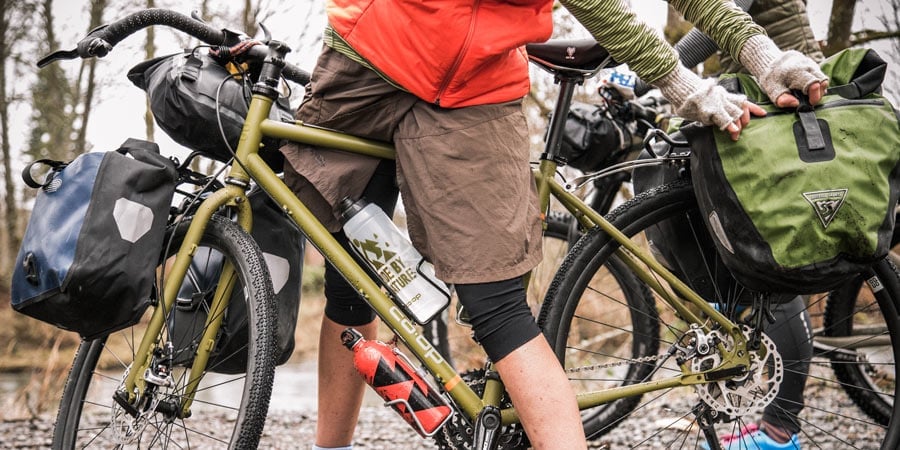
A typical gear setup for beginners:
- Daypack: Good for light, bulky items or anything sensitive to vibration.
- Dry bag secured to a rear rack: Holds heavier items.
- Handlebar bag (or dry bag lashed to the bars): For light to moderate items (e.g., tent, pad, clothing).
- Water bottle cages: Keeps water weight low and centered.
- Panniers: Optional for heavy items (e.g., water, food, stove).
- Bike trailers: Optional for group/family gear or very heavy items.
Bikepacking enthusiasts who ride singletrack trails seek a more streamlined approach. Panniers are skipped because their width makes them easily damaged on narrow trails. A rear rack is left behind to save weight and to reduce the chance of mechanical failure.
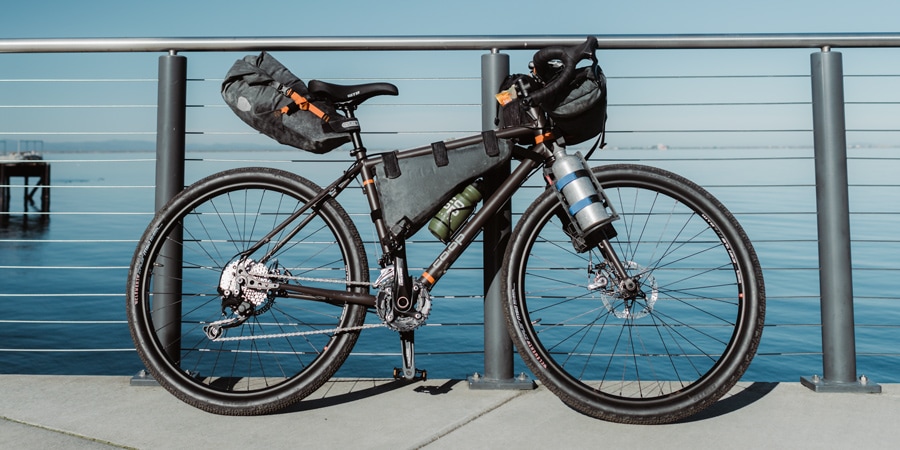
A typical gear setup for enthusiasts:
- Large seat bag: Good for light, bulky items.
- Handlebar bag: For light to moderate items (e.g., tent, pad, clothing) or gear needed quickly (e.g., map, camera, GPS).
- Water bottle cages: Some riders attach an extra cage under the downtube or to the fork.
- Frame bags: Popular for heavy items such as a hydration bladder, food or tools.
- Top-tube/gas tank/bento box bag: For snacks or camera.
- Daypack: Optional for light, bulky items or items vulnerable to vibration.
Many riders become expert at lashing gear onto the bike with tie-down straps or repurposing items to meet their needs. A tent, for instance, can be attached to many handlebars. A bento can be placed backwards at the rear of the top-tube. Nearly everyone experiments to some degree to see what gear setup works best.
Learn more in our articles, How to Choose Bikepacking Bags and How to Pack for Bikepacking.
Gear to Bring Bikepacking
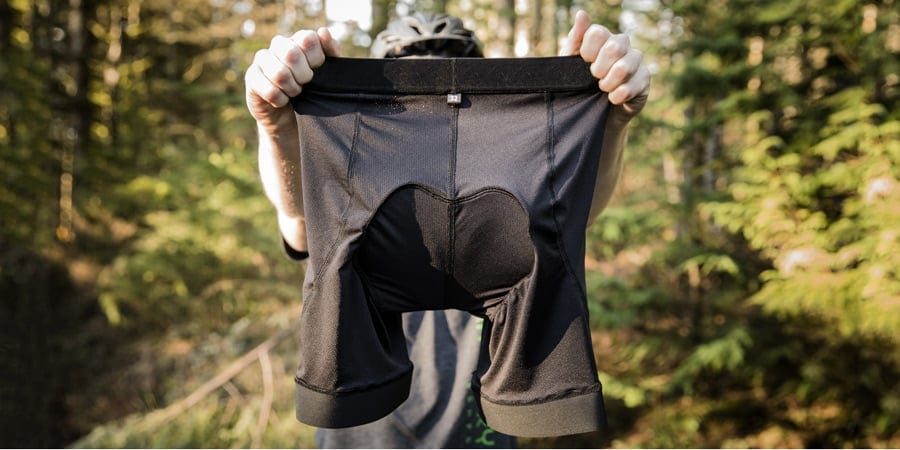
Your bikepacking gear should include the usual backpacking items, such as a sleeping bag, tent, stove and Ten Essentials you'd bring on any such trip.
In addition to backpacking gear, bikepackers should carry some basic bike items: helmet, tube/tire-repair kit, spare tubes and a multi-tool that includes a chain tool. For extended trips, add chain lube, chain pins/power links, spare cables and even a light lock for in-town resupply stops.
Other gear tips: Enhance flat-tire protection by using tire liners and sealant. Riding in the dark? Use a high-output bike light (mounted on your helmet or handlebars) to complement your headlamp for the campsite.
Padded bike shorts and gloves make any ride more comfortable, and SPD-compatible mountain bike shoes (if using clipless pedals) maximize pedaling efficiency and allow normal walking. Keep in mind the added weight may have you walking more than usual, so avoid road-bike shoes with very stiff soles or limited traction.
Consider an extra pair of casual shoes for camp and rest days. Packing a small tarp to protect your bike in foul weather is also a good idea.
Tip: Aim to save weight when possible, but without compromising safety or comfort. Lightweight gear can make riding easier and more fun.
For a complete list, see our Bikepacking Checklist.
Shop Bikepacking Clothing & Gear
Bikepacking Trip-Planning Tips
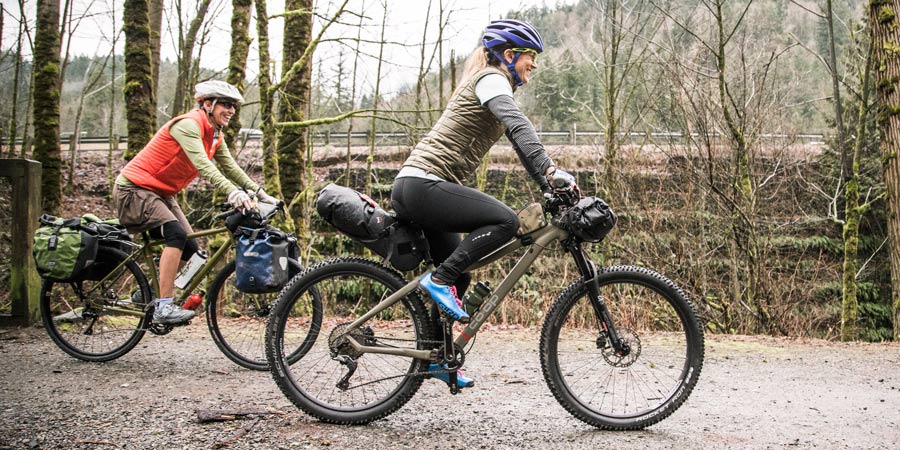
Where can you go bikepacking? Here are a few ideas for first-timers:
- Nearby state park or regional park
- Forest-service roads
- Rails-to-trails corridors
For local advice, talk to the staff at your nearest REI store.
As a rule of thumb, bikepackers can cover 3 times more distance than they would if backpacking the same route on foot. The actual distance, of course, will vary by the route and the individual. Don't overdo the distance; Take time to enjoy the scenery and route.
"S24O" (Sub-24-Hour Overnight) bikepacking trips are quite popular. This typically means rolling out on a Friday after work or midday on a Saturday, taking back roads or trails to a secluded camping spot, then heading back the next morning. It's nothing fancy or complicated; just a simple getaway from daily life.
Learn lots more about planning your adventure in our article, How to Plan a Bikepacking Route.
Bikepacking Riding Tips
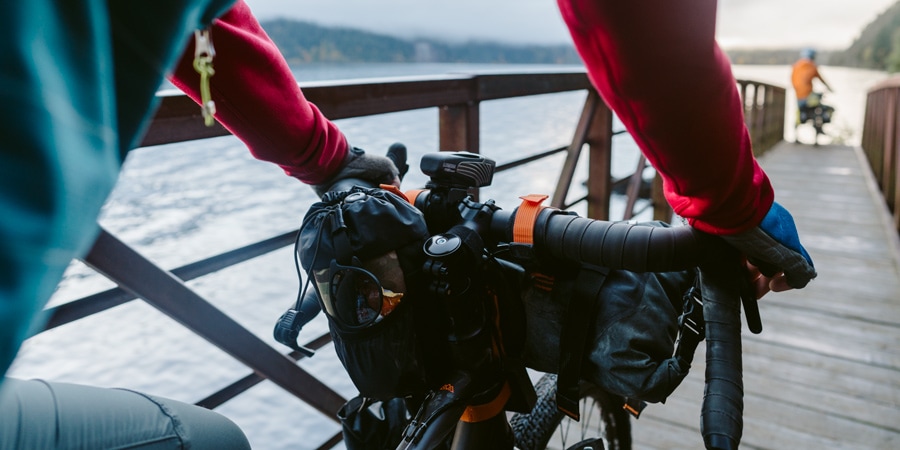
Bikepacking means you'll be carrying your own weight and the weight of your gear. This requires additional riding precautions. Be sure to:
- Limit your speed, especially on downhills.
- Allow longer stopping distances.
- Allow more room for cornering.
- Ride in an easier gear than usual to reduce fatigue.
To support the added weight, add a bit more air to both your tires and your air-sprung suspension (if your bike is so equipped), or add preload to the coil-spring types.
Long rides can result in hand fatigue, but multiple grip positions on your handlebars can help. Consider getting a bike with drop bars (note: drop bars cannot be used on most mountain bikes without making substantial changes to the fit, so see the experts at your local REI bike shop). Or, you can add bar ends, upgrade the grips or use a multi-position bar.
Additional Bikepacking Resources
These websites offer additional bikepacking tips and inspiring rider stories:
